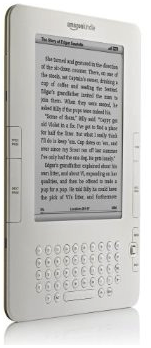It's a Kindle World Now

Moments after I first saw a spy shot of the new Kindle 2, I placed an order for one. I'd seen a couple of the first generation units out in public and loved the screen, but the rest of it looked clunky and the new design fixed at least the outside visual aspects of it. I received my Kindle soon after they began shipping and now that I've used it for a month, I figured it'd probably be high time for a review.
The Great
First off, the screen is great and though a subtle backlight would be handy, it's not too hard to treat it like a book and just keep a small bedside lamp on when reading. In the outdoors in direct sunlight, it's really amazing and crisp in a way you'd never expect a computer screen could be.
Before I got a Kindle, I would typically buy 1-2 books every month and only finish reading a book every 3 or 4 months, starting a lot more than I ever completed. It may just be the novelty of this device, but I've read (and completed) 2 books/week since I got it. The other day I read an entire book in one day, something I haven't done in almost ten years. I haven't read this much since college.
I think there may be a few reasons for the uptick and enjoyment in reading. I really love how you can read the Kindle in the same position. Like most people, I read a bit before going to sleep and I have to say reading a paperback or hard cover book is a little uncomfortable in bed. I love that with the Kindle I can get all warm and snuggled under the covers and I don't have to turn to read opposite pages. I can just lay sideways and I don't have to crane my neck to see opposing pages like I would with a book. I really like the simple % done status in the lower left. I occasionally glance at it every ten page refreshes or so, and it's a motivating metric to see you're actually 27% done with a book or 74% done and it makes me more inclined to complete books after I surpass 50%.
I love the flexibility of getting material to the device. It's easy to buy books online at Amazon.com with a web browser (already whenever I hear about a book, I rush to amazon to see if it's in the Kindle format) and the search within the Kindle is fast enough and usable enough to work (I bought a book on the runway before a flight after hearing about it from a friend, and I got to read it on that flight). I loved that I could buy books for it while it was being shipped by UPS to my door, and when it arrived they showed up on the Home screen.
I'm really impressed with the text conversion via email feature. I've been dumping long blog posts and essays I find online to Readability to trim all the sidebars, navigation, and ads from them, then I copy and paste into a text file that gets sent (as an attachment) to my kindle.com email address. 30 seconds later, it shows up on my Kindle ready to read. It goes without saying that when I copy a 10,000 word piece from a magazine site, I feel bad for stripping the ads so I can full read the article, but I'd also gladly pay $0.25 or $0.50 for the article sent clean to my Kindle without all the copy/paste/email hassles if sites offered an instant "Send to your Kindle for a quarter" button. Hopefully Amazon gets on that.
I've also had the "Send random attachments to your Kindle" feature come in handy for early book reviews. I've gotten two preview copies of books written by friends sent to me as Word documents, which were easily emailed to my Kindle for comfortable reading.
Oh, and as SBJ mentioned on twitter, the Kindle makes it easy to read a book while eating lunch in a way most paperbacks and many hardcover books make nearly impossible without smashing the binding flat to keep them stable.
Lastly, the battery life is amazing. I charge my Kindle once a week and even with reading an hour or two a day in between charges I don't get below 50% battery life with the wireless connect left on. Turning the networking off on the device, I've gone over two weeks without a charge. It's nice to not have to take a charger along if I'm heading out for a trip because I know the battery can hold up for at least a week of normal use.
The Fair to Middling
I have to say that I'm not entirely happy with the button layout on the device. Along the right side (middle) there is a Home button that goes to a central contents menu and below that is a Next Page button used while reading books. On the left side of the device opposite those buttons is a Previous Page and Next Page set. Since I usually hold the device with my right hand, I use the right side, and on more than several occasions when I wanted to go back a page, I accidentally hit the Home button, dumping me out of my book entirely. I guess I wish the Home button was in a prominent place, but not up against the Next Page button in a spot I intuitively think a Previous Page button should go.
There are no real page numbers on the device (due to varying font size you set), just some numbers attached to a book describing its total length and a small indicator of which parts the device is currently showing (like a page might say showing "234-244" at the bottom with a total book length of 3572). I personally like the % done number on the lower left, but the content location and total length number in the bottom middle and bottom left are meaningless data junk to me. I'd personally prefer a clock in the lower right that I could glance at every few pages to see if I'm up past my intended bedtime. It's actually kind of a hassle to figure out what time it is because it's not shown by default while reading a book, and I usually hit the menu button to see the time and hit it again to return to my reading.
Overall, the experimental web browser support is about as good as your average cellphone browser. Gmail kind of sorta works but text wraps badly and the joystick navigation is slightly clunky. The keyboard is seldom used and the buttons are small and require more effort than they should. I've never been in a situation where I used a Kindle over my iPhone's superior browser but it may come in handy in a pinch.
The Bad
I'll admit my biggest problem with the Kindle is imaginary. I have to say that I trust Amazon and I love books, and the Kindle is the most convenient device on earth for any book lover, but deep down, I know it's a dangerously convenient device. There's a central point of control (Amazon, which I trust to do the right thing for now, but in the future, who knows), there is DRM, it isn't the most open device (PDF support can be shaky), and you can't really share e-books with anyone like you can an actual book. I say this as a book lover -- I have walls of bookshelves and I love to loan stuff to friends, and I love that my nightstand no longer is crowded with a dozen titles stacked next to it, but I fear for some future 10 years from now where libraries suffer from people no longer having huge amounts of physical books to donate and share, or something awful happening to Amazon and books being banned from the device, or even if the central servers fail and I lose my fake electronic books. I wish there were more free public domain options and I wasn't just lining Amazon's pockets any time I pick up the device. Deep down, I know there's something wrong about abandoning 500 years of beautiful history of the printed word to embrace an electronic commercial text reader but I guess I haven't read enough Sci-Fi to fully articulate why I should be more afraid than I already am at the ramifications of the device.
I know it's a bargain for the device if you think about a lifetime free 3G connection comes along with it, but I have to say the $359 price tag seems too high. At $99 or $199, I'd give these away as gifts to everyone I know and I would hope many more people would buy them. I've already read a dozen books and I purchased those along with at least a dozen more so hopefully in the future they could treat the Kindle as the free razor with the ebooks as the razor blades that make up for the hardware costs. I'm sure over the next year I'll eventually match the sticker price of the Kindle and over the next few years I may end up spending thousands on the device.
I guess lastly, I kind of hate the name Kindle. It doesn't make me think of a brain getting excited. My first association wasn't "oh it kindles your interest" but rather "kindle, you know like kindling, like how paper is used in a fire." It's probably just me, but the first thing I think about when I hear the word "Kindle" is book burning and censorship and every ugly mental image from
Fahrenheit 451.
Conclusion
I love the hell out of the Kindle 2. I wish it were cheaper and I wish there were open APIs to the device and tons of free book options, but it's really simple to use, the screen works great for me, and I'm reading tons of books without having to send a UPS truck to my door several times a week. I can't recommend it enough.
Subscribe to our newsletter.
Be the first to know - subscribe today





